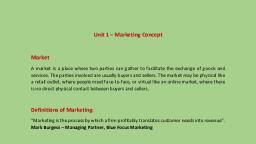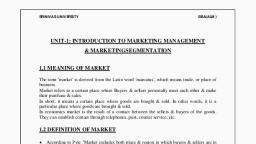Page 1 :
Marketing, •, , •, •, , •, , What is marketing? Many people think of marketing as only selling and advertising., We are bombarded every day with TV commercials, catalogues, spiels from, salespeople, and online pitches. However, selling and advertising are only the tip of, the marketing iceberg. Today, marketing must be understood not in the old sense of, making a sale—“telling and selling”—but in the new sense of satisfying customer, needs. If the marketer engages consumers effectively, understands their needs,, develops products that provide superior customer value, and prices, distributes, and, promotes them well, these products will sell easily., In fact, according to management guru Peter Drucker, “The aim of marketing is to, make selling unnecessary.”, Selling and advertising are only part of a larger marketing mix—a set of marketing, tools that work together to satisfy customer needs and build customer relationships., Broadly defined, marketing is a social and managerial process by which individuals, and organizations obtain what they need and want through creating and exchanging, value with others. In a narrower business context, marketing involves building, profitable, value-laden exchange relationships with customers., Hence, we define marketing as the process by which companies create value for, customers and build strong customer relationships in order to capture value from, customers in return., , Marketing is the process of discovering and translating consumer needs and wants into, products and services, creating demand for these products and services and then in turn, expanding this demand. (H.L. Hansen.), Marketing is the business process by which products are matched with markets and through, which transfer of ownership are affected. (Edward W. Cundiff), Marketing consists of the performance of business activities that direct the flow of goods, and services from producers or suppliers to consumers or end-users. (American Marketing, Association), , The Marketing Process, Given figure presents a simple, five-step model of the marketing process for creating and, capturing customer value. In the first four steps, companies work to understand consumers,, create customer value, and build strong customer relationships. In the final step,, companies reap the rewards of creating superior customer value. By creating value for, consumers, they in turn capture value from consumers in the form of sales, profits, and, long-term customer equity.
Page 2 :
Main Elements of Marketing System, The above figure shows the main elements in a marketing system. Marketing involves, servinga market of final consumers in the face of competitors. The company and, competitorsresearch the market and interact with consumers to understand their needs., Then they createand send their market offerings and messages to consumers, either directly, or throughmarketing intermediaries., Each party in the system is affected by major environmentalforces (demographic, economic,, natural, technological, political, and social/cultural)., Each party in the system adds value for the next level. The arrows represent relationships, that must be developed and managed. Thus, a company’s success at building profitable, relationships depend not only on its own actions but also on how well the entire, system serves the needs of final consumers.
Page 3 :
Marketing Management Orientations, Marketing management wants to design strategies that will build profitable relationships, with target consumers. But what philosophy should guide these marketing strategies? What, weight should be given to the interests of customers, the organization, and society? Very, often, these interests conflict., There are five alternative concepts under which organizations design and carry out their, marketing strategies: the production, product, selling, marketing, and societal marketing, concepts., The Production Concept, • The production concept holds that consumers will favourproducts that are available, and highly affordable. Therefore, management should focus onimproving production, and distribution efficiency., • This concept is one of the oldest orientationsthat guide sellers., • The production concept is still a useful philosophy in some situations. For, example,both personal computer maker Lenovo and home appliance maker Haier, dominate thehighly competitive, price-sensitive Chinese market through low labour, costs, high productionefficiency, and mass distribution. However, although useful in, some situations,the production concept can lead to marketing myopia. Companies, adopting this orientationrun a major risk of focusing too narrowly on their own, operations and losing sightof the real objective—satisfying customer needs and, building customer relationships., The Product Concept, • The product concept holds that consumers will favour productsthat offer the most in, quality, performance, and innovative features., • Under this concept,marketing strategy focuses on making continual product, improvements., • Product quality and improvement are important parts of most marketing strategies., • However, focusing only on the company’s products can also lead to marketing, myopia.For example, some manufacturers believe that if they can “build a better, mousetrap, theworld will beat a path to their door.” But they are often rudely, shocked. Buyers may belooking for a better solution to a mouse problem but not, necessarily for a better mousetrap.The better solution might be a chemical spray, an, exterminating service, a housecat, or something else that suits their needs even, better than a mousetrap. Furthermore, abetter mousetrap will not sell unless the, manufacturer designs, packages, and prices itattractively; places it in convenient, distribution channels; brings it to the attention ofpeople who need it; and convinces, buyers that it is a better product., , The Selling Concept
Page 4 :
•, •, •, , •, , Many companies follow the selling concept, which holds thatconsumers will not buy, enough of the firm’s products unless it undertakes a large-scaleselling and, promotion effort., The selling concept is typically practised with unsoughtgoods—those that buyers do, not normally think of buying, such as insurance or burialplots., These industries must be good at tracking down prospects and selling them on, aproduct’s benefits.Such aggressive selling, however, carries high risks. It focuses on, creating sales transactionsrather than on building long-term, profitable customer, relationships., The aim isoften to sell what the company makes rather than making what the, market wants. Itassumes that customers who are coaxed into buying the product will, like it. Or, if theydon’t like it, they will possibly forget their disappointment and buy it, again later. Theseare usually poor assumptions., , The Marketing Concept, • The marketing concept holds that achieving organizationalgoals depends on, knowing the needs and wants of target markets and delivering thedesired, satisfactions better than competitors do., • Under the marketing concept, customerfocus and value are the paths to sales and, profits. Instead of a product-centred make-andsellphilosophy, the marketing concept, is a customer-centred sense-and-respond philosophy., • The job is not to find the right customers for your product but to find the right, productsfor your customers., • The below figure contrasts the selling concept and the marketing concept., The selling concepttakes an inside-out perspective. It starts with the factory, focuses, on the company’sexisting products, and calls for heavy selling and promotion to, obtain profitable sales. Itfocuses primarily on customer conquest—getting shortterm sales with little concernabout who buys or why.In contrast, the marketing, concept takes an outside-in perspective. As Herb Kelleher,the colourful founder of, Southwest Airlines, once put it, “We don’t have a marketingdepartment; we have a, customer department.”, • The marketing concept starts with a welldefinedmarket, focuses on customer needs,, and integrates all the marketing activities thataffect customers. In turn, it yields, profits by creating relationships with the right customersbased on customer value, and satisfaction., • Implementing the marketing concept often means more than simply responding, tocustomers’ stated desires and obvious needs., • Customer-driven companies research customersdeeply to learn about their desires,, gather new product ideas, and test productimprovements. Such customer-driven, marketing usually works well when a clear needexists and when customers know, what they want.
Page 5 :
The Societal Marketing Concept, • The societal marketing concept questionswhether the pure marketing concept, overlooks possible conflicts between consumershort-run wants and consumer longrun welfare. Is a firm that satisfies the immediate needsand wants of target markets, always doing what’s best for its consumers in the long run?, • The societal marketing concept holds that marketing strategy should deliver value, tocustomers in a way that maintains or improves both the consumer’s and society’s, wellbeing., • It calls for sustainable marketing—socially and environmentally responsible, marketingthat meets the present needs of consumers and businesses while also, preserving orenhancing the ability of future generations to meet their needs., • Even more broadly, many leading business and marketing thinkers are nowpreaching, the concept of shared value, which recognizes that societal needs, not justeconomic, needs, define markets., • The conceptof shared value focuses on creating economicvalue in a way that also, creates value forsociety., • A growing number of companiesknown for their hard-nosed approaches, tobusiness—such as GE, Google, IBM, Intel,Johnson & Johnson, Nestlé, Unilever,, andWalmart—are rethinking the interactionsbetween society and corporate, performance., • They are concerned not just with short-termeconomic gains, but with the well-being, oftheir customers, the depletion of naturalresources vital to their businesses, the, viabilityof key suppliers, and the economic well-beingof the communities in which, they produceand sell., , Companies should balance three considerations in setting their marketingstrategies:, company profits, consumer wants, and society’s interests.
Page 6 :
Companies should balance three considerations in setting their marketing strategies:, company profits, the consumer wants, and society’s interests., , 1. Society (Human Welfare), Companies must make sure the products, services, actions, investment innovations servers, society first., 2. Consumers (Satisfaction), Products and services should be satisfying the consumer’s needs., 3. Company (Profits), Building long-term customer relationships, being socially responsible, and providing, satisfactory products are important for profit-making and wealth maximization., , Objectives of Societal Marketing Concept, •, •, •, •, •, •, , To maintain a long-term relationship with customers., To create a better image in the society for the company than it’s competitors., To carry out its social responsibilities., Developing community awareness towards its brands., To carry out its social responsibilities., To increase the consumer base and market share.
Page 7 :
MARKETING MIX, , •, •, , •, , •, , •, , The process of marketing involves creating a market offering, to satisfy the needs, and wants of the present and potential buyers., The real question is how to create a market offering. Let us say a profitable business, opportunity is seen by some firm in the field of producing soft drinks. To develop and, market a new brand of soft drinks, a number of important decisions will have to be, taken for example whether to go for any collaboration with a foreign manufacturer, of soft drinks, whether to produce for the local market or for a wider market, what, will be the features of the new product, and so on., There are large number of factors affecting marketing decisions. These can broadly, be divided into two categories:, (i), controllable factors, and, (ii), non-controllable factors., Controllable factors are those factors which can be influenced at the level of the, firm. In the previous illustration, for example, whether the drink will be packed in, glass bottles or plastic cans; what will be the name (brand name) of the drink; at, what price it will be sold, (at par with the price at which other competitive brands, are sold or below it or above it); what distribution network will be used to make the, product available (e.g., hotels, restaurants, groceries shops, kiosks selling cigarette,, paan, etc.) to the buyers whether the new soft drink will be promoted by putting up, advertisements in newspaper or magazine or on radio or television; or say if, newspaper, whether in a local newspaper or a national daily; whether in a paper of, regional language or an English daily, etc. is decided at the level of marketing, manager of the firm., However, there are certain other factors which affect the decision but are not, controllable at the firm’s level. These are called environmental variables. For, example, the political factors such as the government policy on whether to allow any, technical or financial collaboration in the area of soft drinks, production or economic, factors such as rate of inflation prevailing in a given period or a credit policy of the
Page 8 :
•, •, , •, , •, , central bank affecting the total availability of money in themarket, all of which affect, the sale of a particular product but cannot be controlled or influenced by the, decisions at the level of a firm., To be successful, the decisions regarding ‘controllable factors’ are to be taken, keeping the environmental variables into consideration., The controllable variables become marketing tools, which are constantly shaped and, reshaped by marketing managers, to achieve marketing success. For example, a firm, can reshape a market offering by bringing in a change in any of the variable under its, own control, say introducing a change in the price or promotion offer or product, features or channel used to make the product available to buyers., Thus, from a number of alternatives available a firm chooses a particular, combination to develop a market offering. The combination of variables chosen by a, firm to prepare its market offering is also called marketing mix., Thus, marketing mix is described as the set of marketing tools that a firm uses to, pursue its marketing objectives in a target market., , ELEMENTS OF MARKETING MIX, The marketing mix consists of various elements, which have broadly been classified into four, categories, popularly known as four Ps of marketing. These are: (i) Product, (ii) Price, (iii), Place, and (iv) Promotion. These are briefly discussed as follows:, , 1. Product:, •, •, , •, , •, , •, •, , Product means goods or services or ‘anything of value’, which is offered to the, market for sale., For example, Hindustan lever offers number of consumer products like toiletries, (Close-Up toothpaste, Lifebuoy soap, etc.),detergent powder (Surf, Wheel), food, products (Refined Vegetable Oil); Tata offers Tata Steel, Trucks, Salt and a large, number of other products; LG Electronics offers televisions, refrigerators, colour, monitors for computers, etc; Amul offers a number of food products (Amul milk,, ghee, butter, cheese, chocolates, etc.)., The concept of product relates to not only the physical product as mentioned in the, above examples but also the benefits offered by it from customer’s view point (for, example toothpaste is bought for whitening teeth, strengthening gums, etc.)., The concept of product also include the extended product or what is offered to the, customers by way of after sales services, handling complaints, availability of spare, parts etc., These aspects are very important, particularly in the marketing of consumer durable, products (like Automobiles, Refrigerators, etc.)., The important product decisions include deciding about the features, quality,, packaging, labelling and branding of the products.
Page 9 :
2. Price:, •, •, •, , •, , Price is the amount of money customers have to pay to obtain the product., In case of most of the products, level of price affects the level of their demand., The marketers have not only to decide about the objectives of price setting but, to analyse the factors determining the price and fix a price for the firm’s, products., Decisions have also to be taken in respect of discounts to customers, traders and, credit terms, etc. so that customers perceive the price to be in line with the value, of the product., , 3. Place:, •, •, , •, , •, , Place or Physical Distribution include activities that make firm’s products available to, the target customers., Important decision areas in this respect include selection of dealers or, intermediaries to reach the customers, providing support to the intermediaries (by, way of discounts, promotional campaigns, etc.)., The intermediaries in turn keep inventory of the firm’s products, demonstrate them, to potential buyers, negotiate price with buyers, close sales and also service the, products after the sale., The other decision areas relate to managing inventory, storage and warehousing and, transportation of goods from the place it is produced to the place it is required by, the buyers., , 4. Promotion:, •, , •, , •, •, , •, , Promotion of products and services include activities that communicate availability,, features, merits, etc. of the products to the target customers and persuade them to, buy it., Most marketing organisations, undertake various promotional activities and spend, substantial amount of money on the promotion of their goods through using number, of tools such as advertising, personal selling and sales promotion techniques (like, price discounts, free samples, etc.)., A large number of decisions are to be taken in each of the area specified above., For example, in the respect of advertising it is important to decide about the, message, the media to be used (example, print-media–newspaper, magazines, etc., the objections of customers, etc.)., The success of a market offer will depend on how well these ingredients are mixed, to create superior value for the customers and simultaneously achieve their sale and, profit objectives.
Page 10 :
The extended 7 Ps:, People – All companies are reliant on the people who run them from front line Sales staff to, the Managing Director. Having the right people is essential because they are as much a part, of your business offering as the products/services you are offering., Processes –The delivery of your service is usually done with the customer present so how, the service is delivered is once again part of what the consumer is paying for., Physical Evidence – Almost all services include some physical elements even if the bulk of, what the consumer is paying for is intangible. For example a hair salon would provide their, client with a completed hairdo and an insurance company would give their customers some, form of printed material. Even if the material is not physically printed (in the case of PDFs), they are still receiving a “physical product” by this definition.










































































